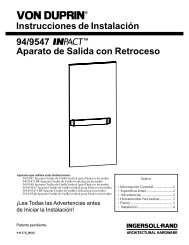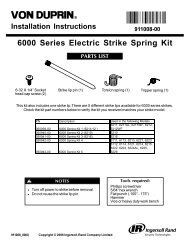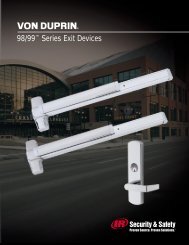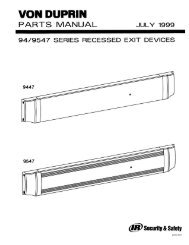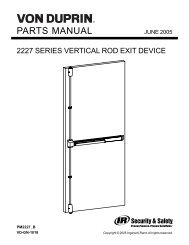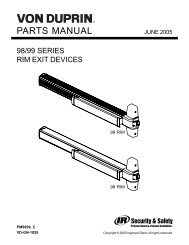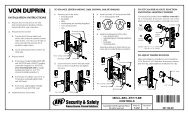Fire, Life Safety & Accessibility Codes - Von Duprin
Fire, Life Safety & Accessibility Codes - Von Duprin
Fire, Life Safety & Accessibility Codes - Von Duprin
Create successful ePaper yourself
Turn your PDF publications into a flip-book with our unique Google optimized e-Paper software.
Bolt Locks (Flush and Surface Bolts) (1008.1.8.4)<br />
Manually operated flush bolts and surface bolts are not permitted;<br />
exceptions: doors not required for egress in dwelling units or<br />
sleeping units, and doors to storage or equipment rooms<br />
Unlatching (1008.1.8.5)<br />
Unlatching any leaf shall not require more than one operation;<br />
exceptions: places of detention or restraint, where manual bolts<br />
are permitted by section 1008.1.8.4, doors with auto flush bolts<br />
and doors from individual dwelling units and guest rooms as<br />
permitted by section 1008.1.8.3<br />
Delayed Egress Locks (1008.1.8.6)<br />
delayed egress devices may be used in any occupancy except<br />
Group A, E, and H, in buildings equipped throughout with an<br />
automatic sprinkler or automatic smoke or heat detection system,<br />
as long as:<br />
· upon actuation of the fire alarm or sprinkler system,<br />
there must be no delay, and<br />
· there is no delay upon loss of power to the egress<br />
control device, and<br />
· the device has the capability of being unlocked manually<br />
by a signal from the fire command center, and<br />
· latch is released within 15 seconds when a force of<br />
15 pounds maximum is applied for 1 second, device may<br />
only be rearmed manually; exception: code official may<br />
approve 30 second delay, and<br />
· initiation of cycle shall activate audible alarm in vicinity<br />
of door, and<br />
· sign with 1" high letters mounted on the door within<br />
12" of the release device states "Push until alarm sounds.<br />
Door can be opened in 15 seconds.", and<br />
· emergency lighting must be provided at the door<br />
a building occupant shall not encounter more than 1 delay before<br />
entering an exit<br />
877.840.3621 • www.securitytechnologies.ingersollrand.com<br />
Stairway Doors (1008.1.8.7)<br />
Interior stairway means of egress doors shall be openable from both<br />
sides without the use of a key or special knowledge or effort.<br />
Exceptions:<br />
· stairway discharge doors shall be openable from the egress<br />
side and shall only be locked from the opposite side<br />
· section 403.12 refers to high-rise buildings (over 75 feet<br />
in height) and states that stair doors which are locked on the<br />
stair side must unlock simultaneously without unlatching upon a<br />
signal from the fire command system, and that a telephone or<br />
other 2-way communication device connected to a constantly<br />
attended station must be provided at every fifth floor if the stair<br />
doors are locked<br />
· in stairways serving not more than 4 stories, doors may be locked<br />
on the stair side, as long as they are not locked on the egress side<br />
provided they are openable from the egress side and capable of<br />
being unlocked simultaneously without unlatching upon a signal<br />
from the fire command system<br />
Panic and <strong>Fire</strong> Exit Hardware (1008.1.9)<br />
Doors equipped with latches in groups A or E and serving an<br />
occupant load greater than 50 or in groups H-1, H-2, H-3, H-5<br />
regardless of occupant load shall have panic hardware<br />
· actuating portion of device must extend at least 1/2 the width<br />
of the door leaf<br />
· maximum force to unlatch is 15 pounds<br />
· balanced doors with panic hardware must have push-pad type<br />
panics, and the pad shall not extend more than one-half the<br />
width of the door measured from the latch side<br />
· Electrical rooms with equipment rated 1,200 amperes or<br />
more and over 6 feet wide that contain overcurrent devices,<br />
switching devices or control devices with exit access doors must<br />
be equipped with panic hardware and doors must swing in the<br />
direction of egress.<br />
Positive Pressure (715.4.1)<br />
<strong>Fire</strong> doors must be tested in accordance with NFPA 252 or UL10C;<br />
after 5 minutes into the NFPA 252 test, the neutral pressure level<br />
in the furnace shall be 40" or less above the sill<br />
Temperature Rise Doors (715.4.4)<br />
<strong>Fire</strong> doors in vertical exit enclosures and exit passageways shall<br />
have a max. transmitted temperature end point of not more than<br />
450°F above ambient after 30 minutes of fire test exposure;<br />
exception: not required in buildings equipped throughout with<br />
an automatic sprinkler system<br />
9



